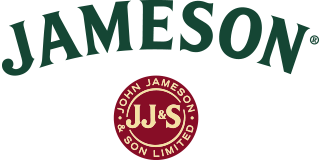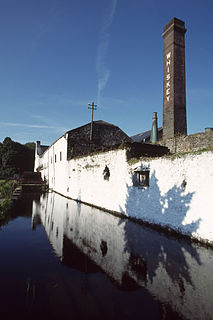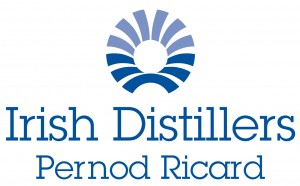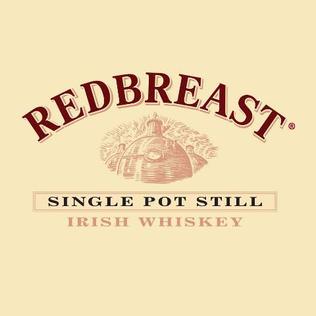Related Research Articles

Irish whiskey is whiskey made on the island of Ireland. The word 'whiskey' comes from the Irish uisce beatha, meaning water of life. Irish whiskey was once the most popular spirit in the world, though a long period of decline from the late 19th century onwards greatly damaged the industry, so much so that although Ireland boasted at least 28 distilleries in the 1890s, by 1966 this number had fallen to just two, and by 1972 the remaining distilleries, Bushmills Distillery and Old Midleton Distillery, were owned by just one company, Irish Distillers.

Jameson is a blended Irish whiskey produced by the Irish Distillers subsidiary of Pernod Ricard. Originally one of the six main Dublin Whiskeys at the Jameson Distillery Bow St., Jameson is now distilled at the New Midleton Distillery in County Cork. It is by far the best-selling Irish whiskey in the world; in 2019, annual sales passed 8 million cases. It has been sold internationally since the early 19th century, and is available to buy in over 130 countries.

Kilbeggan Distillery is an Irish whiskey distillery situated on the River Brosna in Kilbeggan, County Westmeath, Ireland. It is owned by Beam Suntory. A small pot still distillery, the licence to distil dates to 1757, a copy of which can be seen in the distillery.

Powers is a brand of Irish whiskey. Historically a single pot still whiskey, the flagship Powers Gold Label brand was the first Irish whiskey ever to be bottled. In recent years, several single pot still variants have been relaunched under the Powers label.
The Midleton distilleries complex is situated in Midleton, County Cork, Ireland. It is owned by Irish Distillers, a subsidiary of Pernod Ricard. Located alongside is the Old Midleton Distillery, which was established in the early 17th century and now operates as a visitor centre known as the Jameson Experience.

Irish Distillers is a subsidiary of the French drinks conglomerate Pernod Ricard. It is the largest distiller of Irish whiskey, distilling popular brands such as Jameson and Powers, in addition to premium whiskeys such as Redbreast and Midleton Very Rare. In addition to whiskey, Irish Distillers also produces a number of other spirit products such as gin and vodka.

Redbreast is a brand of single pot still Irish Whiskey produced by Irish Distillers. It was originally bottled by Gilbey's, a Dublin spirits merchant using distillate sourced from Jameson's Bow Street Distillery. In the 1980s, the brand was purchased by Irish Distillers, the producer of Jameson. It is the largest selling single pot still Irish whiskey in the world.
Jameson Distillery Bow St. is an Irish whiskey tourist attraction located just off Smithfield Square in Dublin, Ireland. Jameson Distillery Bow St. is the original site where Jameson Irish Whiskey was distilled until 1971. It is now a visitors centre that provides guided tours, tutored whiskey tastings, JJs bar and a gift shop.
The Jameson Experience, Midleton, is an Irish whiskey museum and visitor centre located in the Old Midleton Distillery in Midleton, County Cork, Ireland. Set over 15 acres, since opening as a visitor's centre in 1992, the old distillery has received approximately 100,000 guests per year, receiving 125,000 in 2015.
Allman's Bandon Distillery was an Irish whiskey distillery which was established in 1826 in Bandon, County Cork, Ireland. The distillery closed in 1929 following financial difficulties. However, agents for the company trading under the name Allman, Dowden & Co., may have continued to sell off the existing stock which had built up in bonded warehouses, in both cask and bottled form, until 1939.
The Thomas Street Distillery was an Irish whiskey distillery located in Dublin, Ireland. At its peak, it was Dublin's largest and most productive distillery and with an output of over 2 million gallons per annum, twice that of John Jameson's acclaimed nearby Bow Street distillery. Alfred Barnard, a British author who visited most of the distilleries in the then United Kingdom of Great Britain and Ireland in the late 1880s, wrote that, at the time of his visit, the Thomas Street Distillery may have been the largest whiskey distillery in the world and probably had the highest output of any whiskey distillery in the British Isles. However, the distillery later entered into financial difficulties, and closed in 1926. Although most of the distillery buildings were demolished following its closure, a few were incorporated into the Guinness St. James's Gate Brewery and are still extant.
The North Mall Distillery was an Irish whiskey distillery located in Cork City, Ireland. In its day one of the most famous distilleries in Ireland, the distillery was destroyed by a fire in 1920. Distilling operations never resumed at the North Mall after the fire, and it was later converted into a bottling and storage facility which was used by Irish Distillers until 2007, at which point operations were transferred to Irish Distillers' other bottling facilities in Dublin. In the mid-2000s, much of the site was jointly acquired by University College Cork and Mercy University Hospital, and has since been redeveloped.

The Dundalk Distillery was an Irish whiskey distillery that operated in Dundalk, County Louth, Ireland between 1708 and 1926. It is thought to have been one of the old registered distilleries in Ireland. Two of the distillery buildings, the grain store and maltings, still exist and now house the County Museum and Dundalk Library.

Daly's Distillery was an Irish whiskey distillery which operated in Cork City, Ireland from around 1820 to 1869. In 1867, the distillery was purchased by the Cork Distilleries Company (CDC), in an amalgamation of five cork distilleries. Two years later, in 1869, as the smallest CDC distillery, Daly's Distillery ceased operations. In the years that followed its closure, some of the buildings became part of Shaw's Flour Mill, and Murphy's Brewery, with others continuing to be used as warehouses by Cork Distilleries Company for several years.
The Green Distillery was an Irish whiskey distillery which was established in Cork City, Ireland in 1796. In 1867, the distillery was purchased by the Cork Distilleries Company (CDC), in an amalgamation of five Cork distilleries. Production of whiskey at the distillery likely ceased soon afters its acquisition by the CDC. However, the distillery is known to have remained in use a bonded store by the Cork Distilleries Company for several years thereafter. In the mid-twentieth century, the distillery resumed operations as a gin distillery for a period of time, however, it has since been almost completely demolished.
The Watercourse Distillery was an Irish whiskey distillery which was established in Cork City, Ireland in 1795. In 1867, the distillery was purchased by the Cork Distilleries Company (CDC), in an amalgamation of five Cork distilleries. Following the amalgamation, the distillery was mothballed for a period at the beginning of the 20th century. However, operations at the distillery were later resumed, with production of yeast, industrial alcohol and grain alcohol occurring at the distillery until the 1970s. Distillation ceased at the facility in 1975, when Irish Distillers, who at that stage owned the Watercourse along with several other distilleries in the Republic of Ireland consolidated its operations in a new, purpose-built distillery in Midleton.
The Old Tullamore Distillery was an Irish whiskey distillery which was established in Tullamore, County Offaly, Ireland, in 1829. The original home of Tullamore Dew Irish whiskey, the distillery closed in 1954, having endured financial difficulties for many years, like many Irish whiskey distilleries of the early 20th century.

The Dublin Whiskey Distillery Company Jones Road Distillery also known as the D.W.D. Distillery, Jones Road, or just Jones Road Distillery, was one of the six great Irish whiskey distilleries of Dublin city visited and documented by Alfred Barnard in his seminal 1887 publication "The Whisky Distilleries of the United Kingdom". It was located on the north side of the city on the banks of the river Tolka, approximately a mile north of the city centre. The distillery was built by the Dublin Whiskey Distillery Company Ltd and the Irish whiskey produced sold around the world under the brand name D.W.D.
John Brannick was an Irish whiskey maker, and founder and master distiller of the Dublin Whiskey Distillery Company.
Marlfield Distillery was an Irish whiskey distillery which operated in the village of Marlfield, just outside of Clonmel, Ireland between approximately 1817 and 1856.
References
- 1 2 3 Brian, Townsend (1999). The Lost Distilleries of Ireland. Glasgow: Neil Wilson Publishing. ISBN 1897784872.
- ↑ "Mountrath". laoistidytowns.ie. Retrieved 13 January 2017.
- 1 2 Coote, Sir Charles (1801). General view of the agriculture and manufactures of the Queen's county. Dublin: Graisberry & Campbell.
- ↑ "Distillery - To be let". Dublin Evening Post. 26 August 1794.
- ↑ "A Distiller Wanted". The Dublin Evening Post. 18 April 1797.
- 1 2 "More Minor Than Major: Less Laois Houses". laoishouses.wordpress.com. 20 April 2016. Retrieved 13 January 2017.
- ↑ Second Report of the Commissioners appointed to consider and recommend a general system of railways for Ireland. London. 1838.
- ↑ Slater, Issac (1846). Slater's National Commercial Directory of Ireland. London: I. Slater (late Pigot & Co.).